No position on an NFL football field determines wins and losses more than the quarterback. It is with this understanding that quarterbacks are pushed up the draft board each year, as teams very often base their projections more on promise than production.
This year, Joe Burrow and Tua Tagovailoa will likely come off the board within the first five picks. And at that moment, out of desperation, talent-starved clubs will elevate those in the next tier of quarterbacks — players like Justin Herbert, Jordan Love and Jalen Hurts — to potential first-round options.
Hurts will enter the 2020 NFL Draft ranked as the fourth quarterback on PFF’s final 2020 NFL Draft Big Board and the 65th-rated prospect overall. And while players like Herbert and Love may have a greater “upside,” Jalen Hurts’ ability to avoid negative and inaccurate throws arguably makes him the best option in the draft class’ second tier of passers.
Here, we look at in-rhythm passing — one of the more stable metrics when it comes to assessing quarterback performance — to see where Hurts stacks up against the likes of Jordan Love, Josh Love and Justin Herbert.
[Editor’s note: Check out PFF’s 2020 Mock Draft Hub, NFL Draft Big Board and NFL Mock Draft Simulator. PFF Elite subscribers can also download the 1,100-page 2020 NFL Draft Guide.]
Steady Before Spectacular
It would be disingenuous to suggest that style points don’t matter when it comes to evaluating quarterbacks. Height, weight, speed, arm strength and mobility are just a few of the attractive traits that are pleasing to the eye, but they still offer very little assurance when it comes to predicting exactly how a quarterback will perform at the next level.
The data, however, suggests that productive quarterbacks who throw accurately and avoid negative throws when in rhythm will perform more consistently from season to season.
A season ago, Hurts produced an in-rhythm accuracy percentage (64.2%) that ranks third among PFF’s top 10 quarterback prospects, behind only Burrow and Washington State’s Anthony Gordon. It also bettered the marks of Tua Tagovailoa (61.5%), Josh Love (56.0%) and Justin Herbert (54.0%).
More importantly, however, Hurts did a good job of avoiding the egregious uncatchable and inaccurate passes, as he produced the fifth-lowest percentage of such throws (19.3%) among his peers.
As we know, a high volume of uncatchable and inaccurate passes can lead to a high volume of turnover-worthy plays — which is something Utah State’s Jordan Love struggled with a season ago.
In fact, 27.4% of Love’s in-rhythm attempts last year were classed as uncatchable and inaccurate, which ranked dead last among PFF’s top 10 prospects.
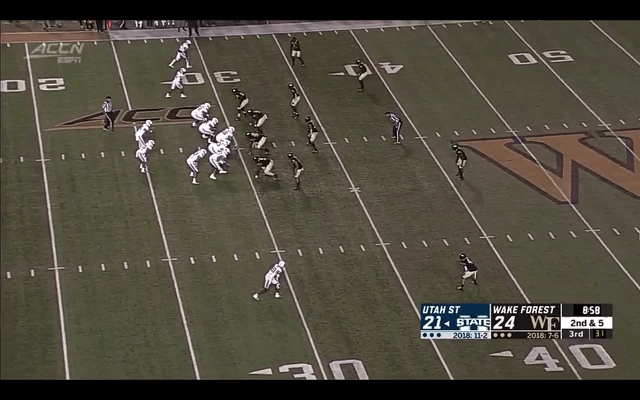
Take the play above as an example. Here, Love released the ball in rhythm and was clearly free from pressure, but he predetermined his throw by staring down the intended receiver in the left slot position. Love failed to look off the “Mike” linebacker, who dropped what should be an easy interception.
Love’s 15 turnover-worthy plays while throwing in rhythm were the second-most out of the top 10 passers on the draft board, while his turnover-worthy play percentage of 5.1% on those ranked last by a wide margin. In comparison, Hurts committed only five turnover-worthy plays on his 187 in-rhythm pass attempts, which resulted in a turnover-worthy play rate of 2.7%.
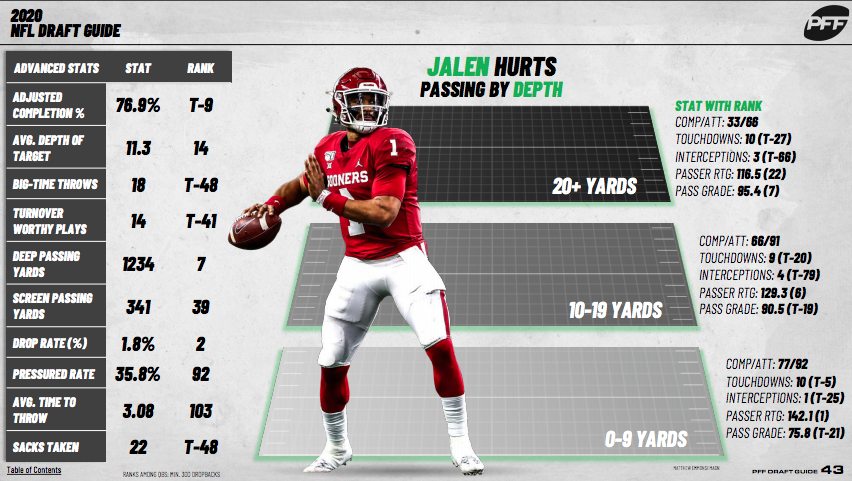
Checking the right boxes
The 6-foot-1, 222-pound Jalen Hurts may not check the same boxes as the physically impressive 6-foot-6, 238-pound Justin Herbert, who has the arm talent to stretch the field and the mobility to score with his legs.
Since winning the Rose Bowl in January and performing well at both the Senior Bowl and the 2020 NFL Scouting Combine, Herbert’s stock has risen largely because of his potential and not necessarily because of his production.
However, his rate of catchable but inaccurate passes — passes that could have been caught but were far from perfectly placed — on in-rhythm throws came in at 24.3% last season, last among the draft’s top-10 quarterbacks. Hurts, in comparison, threw a catchable but inaccurate pass just 16.5% of the time, which ranked third behind only Gordon (14.4%) and Burrow (15.1%).
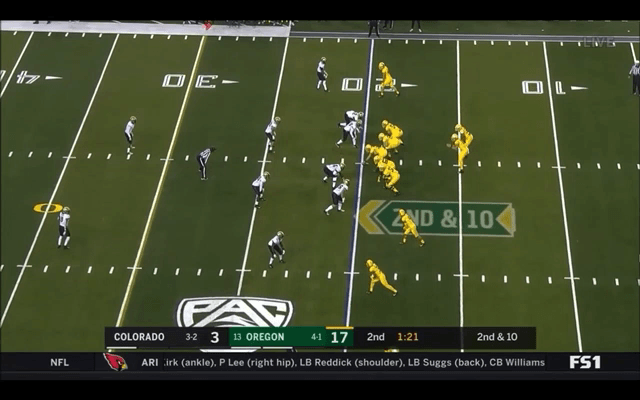
The play above shows Justin Herbert throwing in rhythm with plenty of time to hit the vertical seam route. The catchable but inaccurate pass forces the intended receiver to break stride and wait for the ball. It should have been an explosive pass play for the Oregon quarterback, but instead, it results in an underthrown ball that is nearly intercepted.
The table below shows the in-rhythm passing grade for the top 10 quarterbacks in the 2020 draft class and how the best of them have a lower percentage of negatively graded plays.
2020 QB Class: Highest PFF grade on in-rhythm plays along with negatively graded play rate
| Prospect | PFF grade | Snaps | Negatively graded plays | Negatively graded play % |
| Joe Burrow | 96.1 | 388 | 37 | 9.5% |
| Jalen Hurts | 94.7 | 188 | 30 | 16.0% |
| Tua Tagovailoa | 93.7 | 148 | 20 | 13.5% |
| Jake Fromm | 93.3 | 277 | 44 | 15.9% |
| Jake Luton | 93.2 | 260 | 33 | 12.7% |
| Jacob Eason | 91.6 | 291 | 46 | 15.8% |
| Justin Herbert | 91.4 | 244 | 54 | 22.1% |
| Josh Love | 91.1 | 378 | 68 | 18.0% |
| Anthony Gordon | 90.8 | 477 | 64 | 13.4% |
| Jordan Love | 81.2 | 294 | 60 | 20.4% |
Jalen Hurts’ season total of 30 negatively graded plays when operating in rhythm was the second-lowest total behind only Tagovailoa, and his negatively graded play rate beat the likes of Jordan Love, Justin Herbert and Josh Love. More impressive, however, is the fact that the Oklahoma quarterback’s PFF grade on those plays put him behind only Joe Burrow, the consensus No. 1 pick of the 2020 NFL Draft.
Burrow graded exceptionally well in 2019. His 94.9 overall grade is the best we’ve ever seen at quarterback since 2014. Burrow led this group in big-time throws (43) and touchdown passes (60), and only Georgia’s Jake Fromm (1.7%) produced a lower turnover-worthy play rate than Burrow’s mark of 2.0%.
When in rhythm, Burrow’s impressive uncatchable, inaccurate throw rate of 13.4% was more than two percentage points lower than any of the class’ top signal-callers.
While Hurts didn’t produce the same eye-popping explosive pass plays as Burrow did in 2019, his third-placed 135.2 passer rating from in-rhythm throws wasn’t far off Burrow’s group-leading mark of 149.9. Hurts also finished second to only Tagovailoa in yards per in-rhythm attempt, finishing the season with a figure of 13.4 yards compared to the ‘Bama quarterback’s average of 14.6.
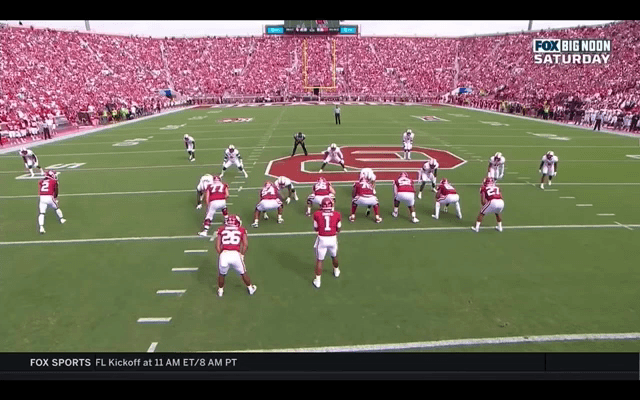
Again, in-rhythm throws should be executed at a high level of efficiency. Here, Hurts had two receivers open on the deep post and the intermediate crossing route. He elevates the play by connecting on the deeper of the two routes with excellent accuracy.
This play is just one of the many that helped Jalen Hurts finish the season with the highest rate of positively graded plays on in-rhythm dropbacks.
2020 QB Class: Highest positively graded play rates on in-rhythm passing plays
| Name | Team | Snaps | Positively graded plays | Positively graded play rate |
| Jalen Hurts | OKLAHOMA | 188 | 93 | 49.5% |
| Tua Tagovailoa | ALABAMA | 148 | 62 | 41.9% |
| Justin Herbert | OREGON | 244 | 101 | 41.4% |
| Jake Fromm | GEORGIA | 277 | 95 | 34.3% |
| Josh Love | S JOSE ST | 378 | 129 | 34.1% |
| Jake Luton | OREGON ST | 260 | 86 | 33.1% |
| Jordan Love | UTAH ST | 294 | 95 | 32.3% |
| Joe Burrow | LSU | 388 | 124 | 32.0% |
| Anthony Gordon | WASH STATE | 477 | 146 | 30.6% |
| Jacob Eason | WASHINGTON | 291 | 87 | 29.9% |
More positives than negatives
Earlier, we examined the data on negatively graded throws — where Hurts separated himself from both Justin Herbert and Jordan Love. But even though most talent evaluators would tell you both Herbert and Love have a greater “upside” than Hurts, the data also shows that Hurts produced positive plays at a higher rate than both Herbert and Love when throwing in rhythm.
Hurts’ 15.9% “accuracy plus” rate (rate of perfectly placed passes) on in-rhythm throws also beat those of Herbert (14.9%) and Jordan Love (10.4%).
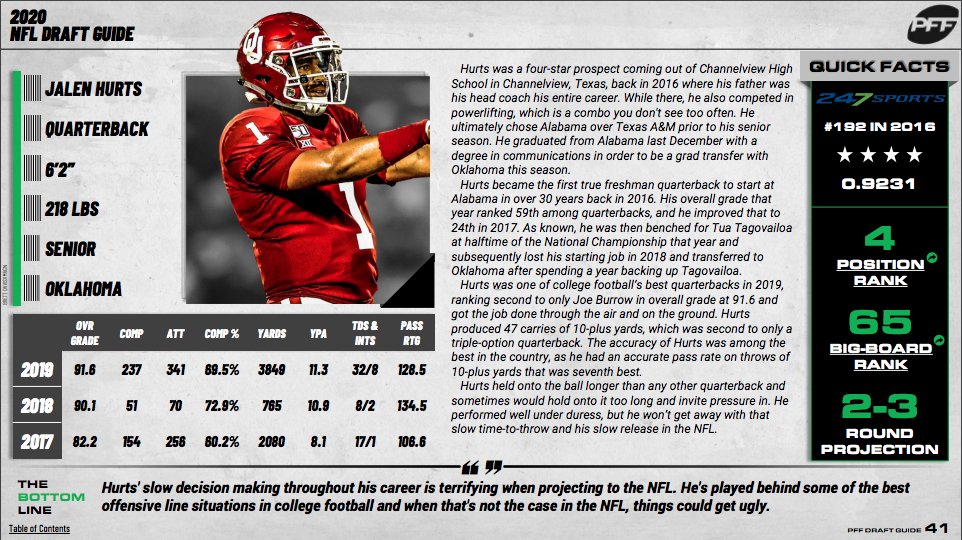
Very few predicted that third-round pick Russell Wilson would outperform quarterbacks like Andrew Luck, Robert Griffin III, Ryan Tannehill and Nick Foles, who were all selected in the first two rounds of the 2012 NFL Draft. After all, Wilson was thought of as an undersized, late-round prospect. Wilson, however, has led the Seattle Seahawks to the postseason in seven of his eight NFL seasons and has graded above 80.0 in six of those years.
I’m not suggesting that Jalen Hurts is Russell Wilson, nor am I saying that he should be selected in the first round after Burrow and Tua have come off the board. But, if avoiding negative throws is the most stable indicator when evaluating quarterbacks, then I believe that teams should at least consider making Hurts their QB3 ahead of Justin Herbert and Jordan Love. Hurts offers teams the opportunity to avoid the common mistake of selecting style over substance — he doesn’t jump off the screen, but he is dependable when performing in rhythm and has proven accuracy, plus decision-making and poise under pressure.
If placed in the right situation with the right coach tending to his talents, Hurts will provide consistency and the invaluable ability to make more positive plays than negative ones.
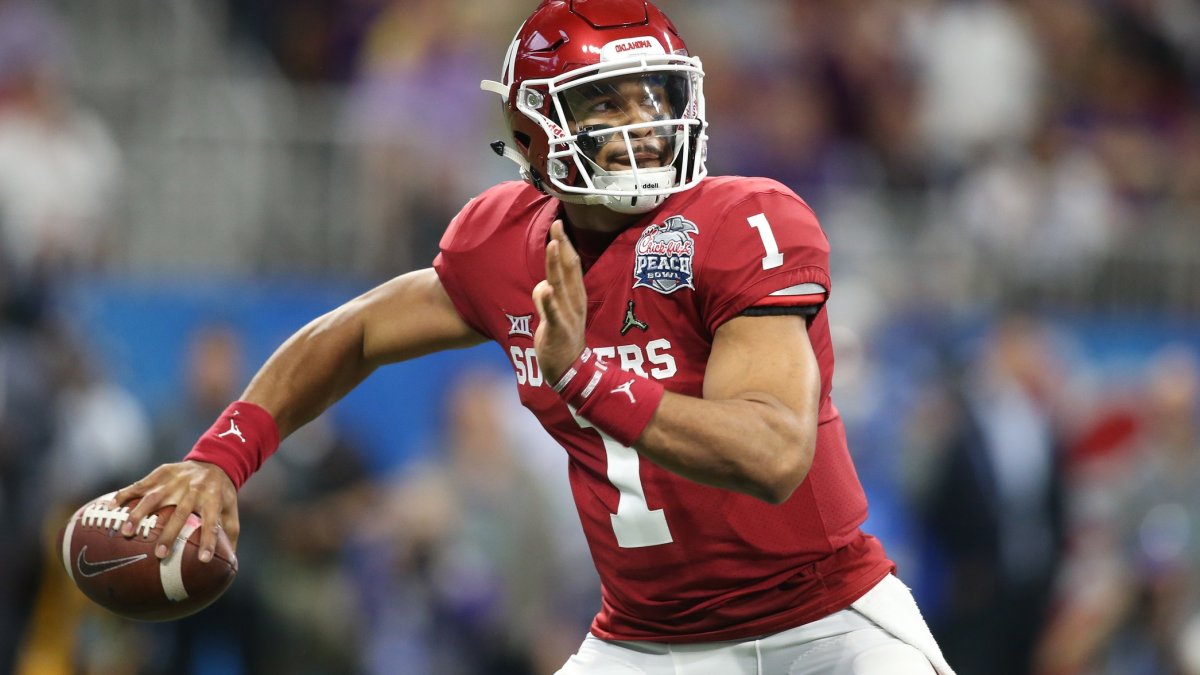


 © 2025 PFF - all rights reserved.
© 2025 PFF - all rights reserved.